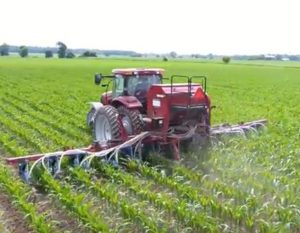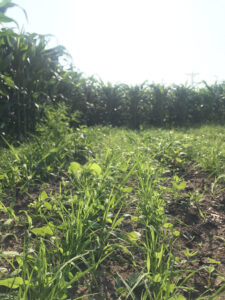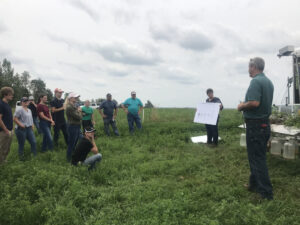
On July 14th, 2021, the Farmland to Shoreland Field Day was held in Shawano County. We had 33 people in attendance at the field day to learn about interseeding and grazing.
This field day was for watershed residents wanting to learn more about what their local farmers are doing to protect the waters around them.
Before we get into the field day specifics, let’s start with some statistics. Just under 41,000 people and 35,000 dairy cows call Shawano County home. In addition,
there are 135 lakes and ponds, 595 miles of rivers and streams with 400 of those miles being trout streams.
Protecting our lands and waters for all the residents is extremely important and we were so happy to highlight to great people doing great things.

To start the day, attendees met on the side of the road at one of Tauchen Harmony Valley fields to show case their use of interseeding on their corn fields.
Interseeding is the use of specialized equipment to plant a cover crop between rows of corn, once it has started to grow. Corn is measured in leaf stages that are described in “V” stages. For example, a corn that is V2 has two leaves visible with leaf collars.
The field that the Farmland to Shoreland attendees were visiting was interseeded into a V2-V3 corn field.
 While at the first location, attendees were given an overview of what a watershed is and which watersheds Shawano County fall in to. From there, attendees learned about important the impacts of tourism and agriculture are for the county followed by information describing the Upper Fox Wolf TMDL (total maximum daily load) and how we can all work together to make improvements.
While at the first location, attendees were given an overview of what a watershed is and which watersheds Shawano County fall in to. From there, attendees learned about important the impacts of tourism and agriculture are for the county followed by information describing the Upper Fox Wolf TMDL (total maximum daily load) and how we can all work together to make improvements.
We then heard from Greg and Steve Tauchen. They shared their experience with interseeding including the highs and lows. From there Matt Brugger of Tilth Agronomy described the interseeding process its importance.
After we wrapped up with the Tauchens, we headed over to J&J Muellers. We started with a box lunch and some great conversations.
After lunch, we learned from Barry Bubolz and Jamie Patton about the importance of creating a healthy root system through the use of cover crops and native plants. Through the use of a rain simulator, we watched how field practices can affect the runoff and infiltration of our rain storms.
plants. Through the use of a rain simulator, we watched how field practices can affect the runoff and infiltration of our rain storms.
The current changes to our climate are causing precipitation events to be less frequent but more intense. This change further increases the need for there to be year round ground cover on our fields to protect the farmers’ top soil and our waterways from sediment and phosphorus pollution.
We learned from Sacia Mueller that grazing their cows has not only helped the health of their cows but also improves their soil and the waters around their farm.
The Muellers let their cows graze each section of field one day at a time. This method allows them to keep their fields in good enough shape that the cows can come back a couple weeks later and graze the same section.
Sacia provided attendees an example of how their rotational grazing operation works. The cows followed her around the field as she completed the work necessary to move them. This includes moving their water bucket and opening the temporary fencing.
More photos and information about the event can be found by contacting the Upper Fox Wolf Demonstration Network, UW-Extension, or Shawano County Land Conservation Department.






